What is an Ecovillage? A Comprehensive Guide
In this post, we delve into the concept of ecovillages, examining these sustainable alternatives to conventional living that are beneficial for both people and the planet. Continue reading to discover what defines an ecovillage, understand its key components, explore a concise history of the movement, and learn about six thriving ecovillage communities. Additionally, we will provide insights on how you can join or even start your own ecovillage.
What is an Ecovillage?
An ecovillage is a type of planned community specifically designed to be sustainable in social, economic, and most importantly ecological practices. The concept emerged from the broader sustainability movement as a way to buck conventional building practices in favor of more sustainable practices that minimize environmental impact while providing a high-quality of life for residents. The goal is to integrate sustainable building practices, renewable energy, regenerative agriculture, and c community living into everyday life.
Key elements of Ecovillages
Sustainable Architecture
Home and building in ecovillages are often constructed using environmentally friendly materials and prioritize reduction in waste and energy consumption. Cob houses, hempcrete, and use of native species in the construction process are examples of sustainable choices in design. Natural heating and light should also be considered.
Renewable Energy
Many ecovillages were founded on the idea of using modern energy sources that move away from petroleum-based fuels. A combination of solar, wind, and geothermal help meet energy needs while reducing carbon externalities.
Organic, Regenerative, Sustainable Agriculture
Most ecovillages also aim to produce as much of their own food as possible using sustainable agriculture practices that buck the trend of monoculture, mechanization, and chemically hazardous production processes. . Organic agriculture avoids the use of synthetic pesticides and fertilizers. Regenerative agriculture is a more holistic approach to farming that works to improve soil health, manage water, improve biodiversity, and sequester carbon with the integration of livestock and minimization of external inputs. Over the past century, ecovillages pushed back against conventional mechanized and fossil fuel intensive agriculture by producing their own organically grown food. Now, regenerative agriculture is supporting even more resilient food systems in ecovillages.
Water Management
Ecovillages strive to efficiently use water resources. Rainwater harvesting, greywater recycling, and natural waste-water treatment systems are examples of practices implemented by some of the large ecovillages in operation today.
Waste Reduction
The aim of many ecovillages is to create a closed-loop system where as much of the resources are reused as possible- where inputs equal outputs and outputs are inputs to other systems. Recycling, composting, and minimizing outside materials are ways to reduce waste.
Community Living
Creating close-knit communities that share resources and responsibilities to each other and the planet is at the heart of the ecovillage concept. This often includes shared meals and community spaces, collective decision-making processes, and mutual support systems.
Economic Sustainability
Some ecovillages work to create their own economies while others work within local and global systems to produce and market goods. While some may employ members of the community full-time, most require that members have external financial resources or income.
Education and Outreach
Core to ecovillages is developing and sharing a new model of living in a way that is more harmonious with nature. They may share their practices through workshops, courses, and tours.
A Brief History of Ecovillages
The term Ecovillage emerged as part of a counterculture movement centered around newly found environmental awareness and a desire to return to living more harmoniously with nature.
In the 1960s and 70s there was a rise in intentional communities influenced by ideas of returning to the land, self-sufficiency, and ecological sustainability. This carried on into the 1980s when sustainable development became a more prominent goal and renewable energy and organic agricultural practices began to become more prevalent.
In 1991, the term “Ecovillage was popularized by Robert Gilman of the Context Institute who defined ecovillages as:
“...human-scale, full-featured settlement in which human activities are harmlessly integrated into the natural world in a way that is supportive of healthy human development, and can be successfully continued into the indefinite future.”
-Robert Gilman
In 1995, the The Global Ecovillage Network (GEN) was founded and the first ecovillage conference was held in Findhorn, Scotland. GEN played a crucial role in linking ecovillages around the world helping them to share knowledge and resources and connect them to prospective residence.
Overall, the history of ecovillages really is a story of a segment of humans that deviated from the path of living in relationship to land and their environment and now is recognizing that the correct path forward is to return to a way of life that is sustainable and resilient.
Examples of Ecovillages
Ecovillages around the world serve as models for sustainable living and community development. Here are some successful examples that have made significant impacts in their regions:
- Findhorn Ecovillage, Scotland
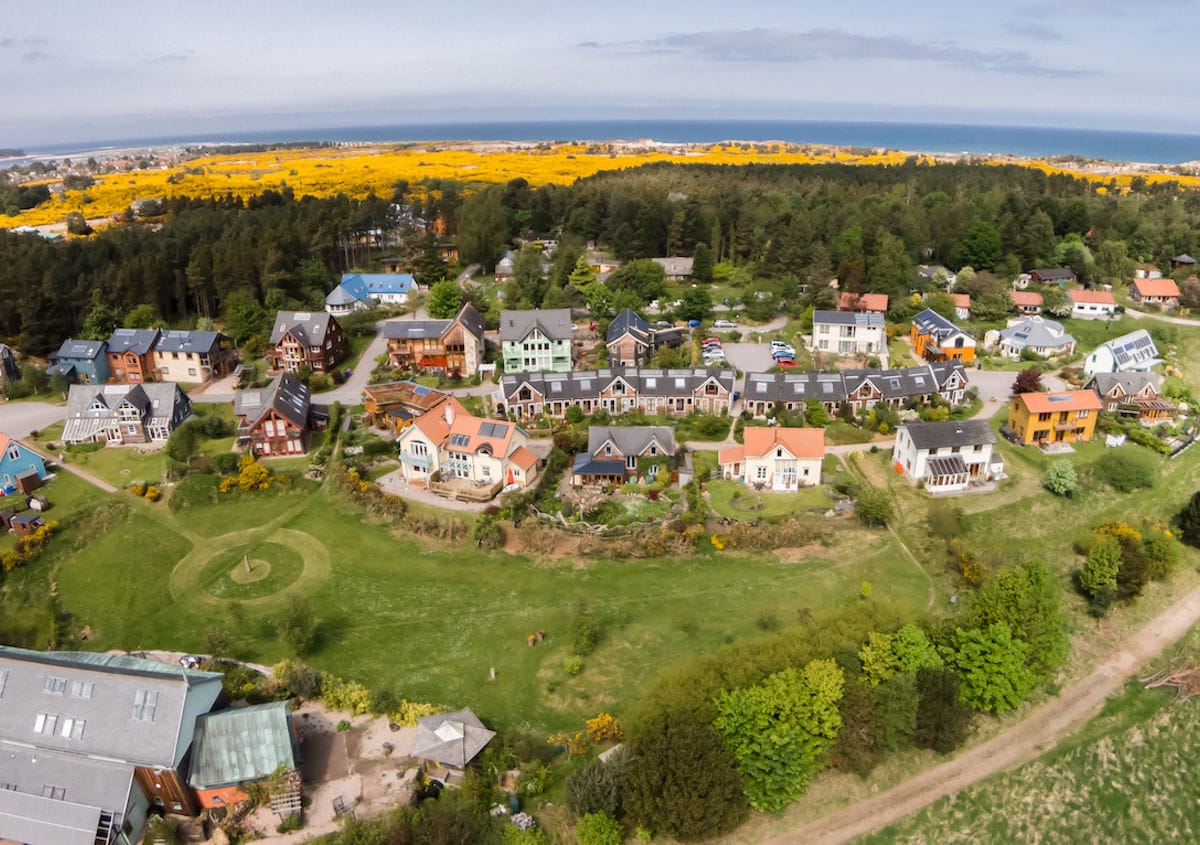
Established in 1962 in Moray, Findhorn is one of the oldest and most well-known ecovillages, renowned for its innovative approaches to ecological building, renewable energy, and organic farming. It is also a spiritual community that emphasizes personal growth and mindfulness. The village includes ecological houses, a biological wastewater treatment facility, wind turbines, and extensive community gardens. It is estimated that Findhorn had over 1,000 residents in 2020.
- Auroville, India
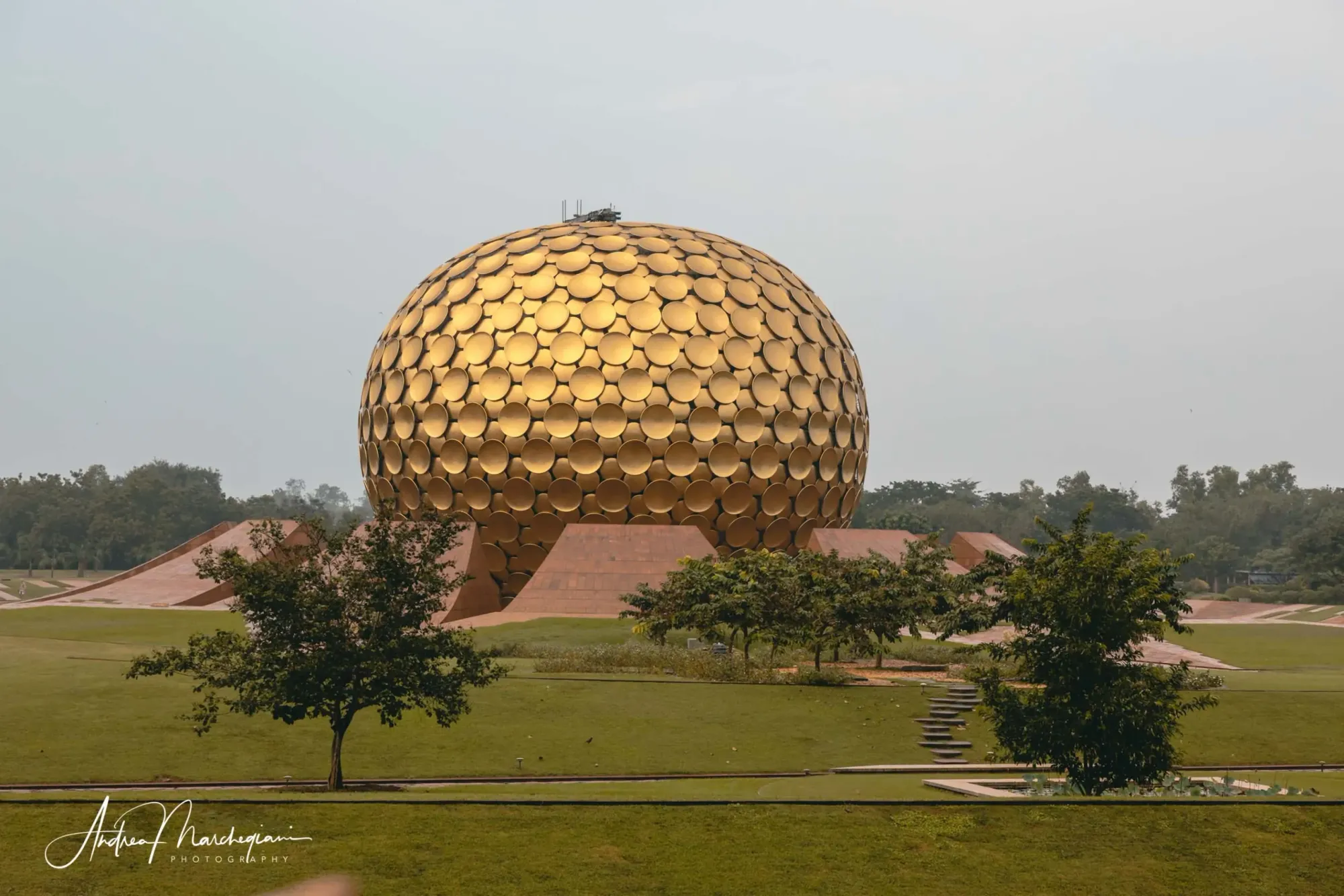
Another old standing ecovillage in Tamil Nadu, India established in 1968. Auroville was founded with the vision of being a universal town where men and women of all countries could live in peace and progressive harmony. It focuses on sustainable living and the realization of human unity.
The community is known for its efforts in reforestation, organic farming, renewable energy (especially solar power), and sustainable building technologies. It’s home to thousands of residents from over 50 countries.
At the center of Auroville is the Matrimandir, designed to be a place to find one’s consciousness, it houses the largest optically-perfect glass sphere in the world at its center.
- Damanhur, Italy
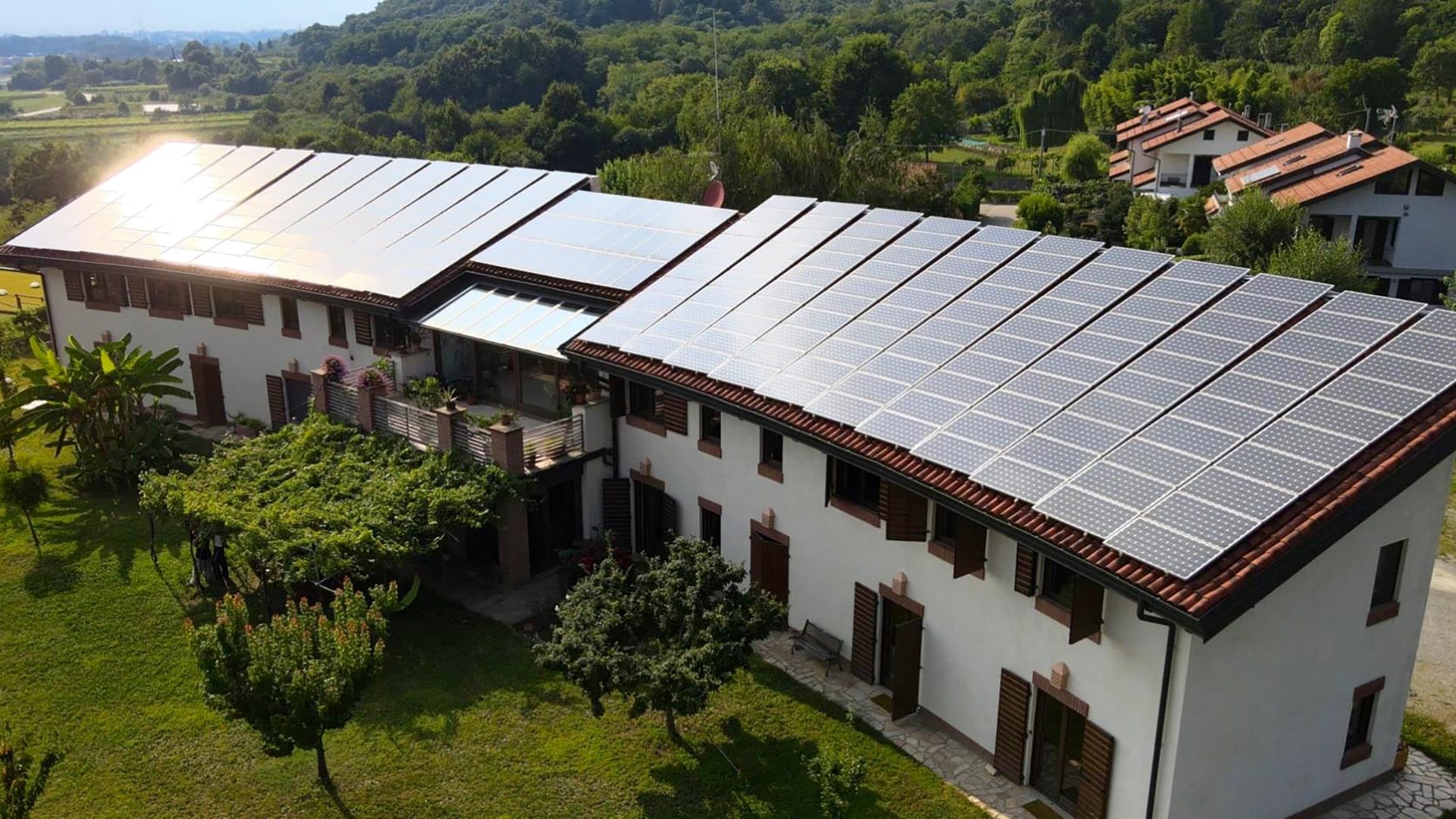
Founded in Piedmont, Italy in 1975, Damanhur is famous for its artistic and spiritual community, with its own unique culture, language, and educational system. It emphasizes spirituality alongside ecological responsibility.
The community has a strong focus on art, which is integrated into its buildings and structures. It also employs sustainable practices such as organic agriculture and the use of renewable energy.
- Ecovillage at Ithaca, USA
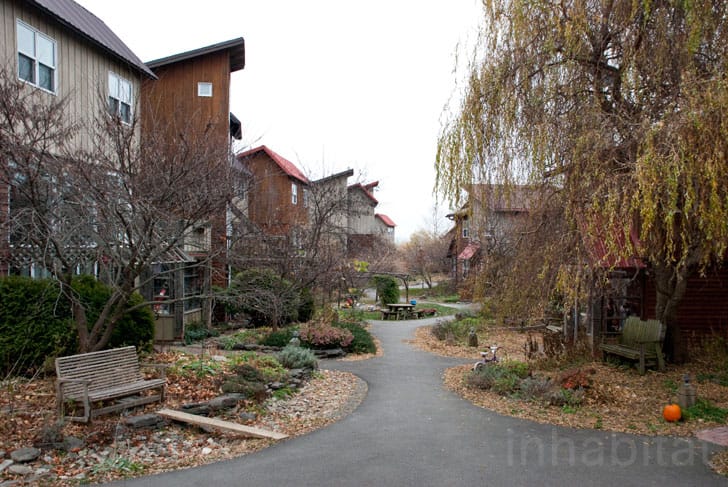
Located in the Finger Lakes region of New York, this ecovillage established in 1991 aims to develop an environmentally, economically, and socially healthy community in the region. It has grown significantly and now includes multiple co-housing neighborhoods.
The village promotes sustainable living through shared community resources, organic farming, consensus decision-making, and educational outreach programs.
- Suderbyn Permaculture Ecovillage, Sweden
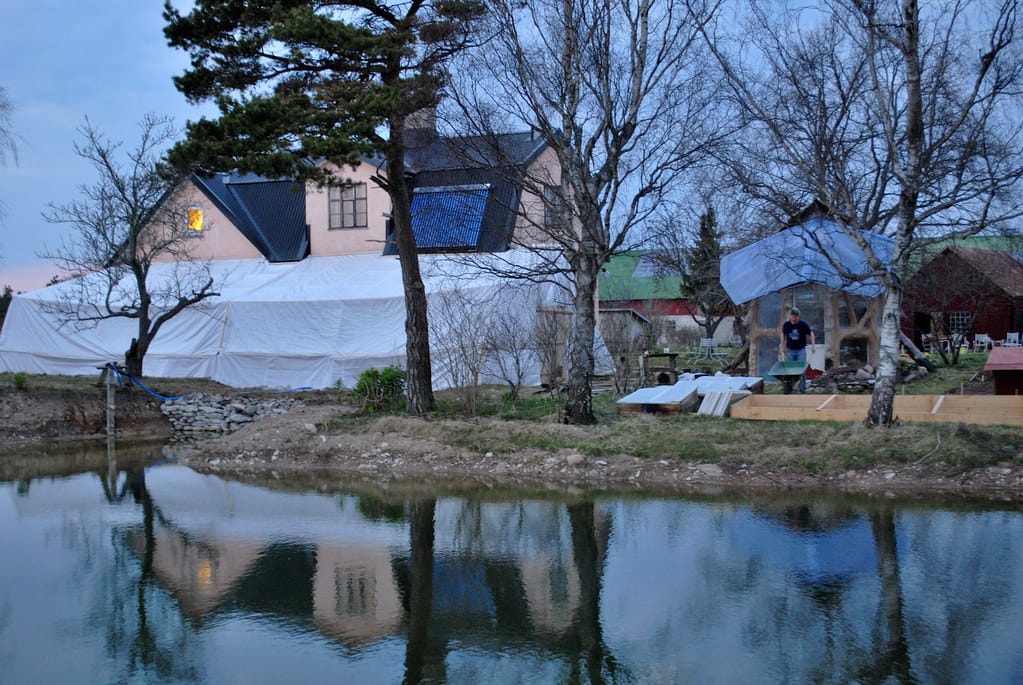
Suderbyn is a relatively young ecovillage founded in 2008 in Gotland, Sweden that practices permaculture and strives to live in harmony with nature. It is a research and education center for sustainable living.
The community uses renewable energy systems, permaculture gardening, and sustainable building methods. It also emphasizes strong community relations and international collaboration.
- Tamera, Portugal

Tamera (1995 in Alentejo, Portugal) is a peace research village with the aim of becoming a self-sufficient, sustainable community. It is focused on developing new models for society that provide peaceful, ecological, and cooperative ways of living.
Tamera's infrastructure includes solar power, water landscapes for water self-sufficiency (including lakes and water retention spaces), and vegan and vegetarian organic farming.
These ecovillages not only promote sustainable ecological practices but also foster innovative social and economic systems. They serve as living laboratories for experimenting with and demonstrating alternative ways of living on Earth.
How do I join an ecovillage?
Joining an ecovillage is a big step in finally committing to a more sustainable and community-oriented lifestyle. Here are the steps to joining one:
Research
Identify the core values and goals that you have for your ideal community. Then start researching to find one that also matches your desired location. The Global Ecovillage Network website can provide detailed information and directory of ecovillages around the world to help you in your search. You can also use social media to connect with communities and keep updated on events and get a flavor for their vision and lifestyle.
Visit
Many ecovillages offer tours, workshops, and temporary stays for prospective members so that you can get a taste for what life will be like as part of the community. Be sure to engage with residents before, during and after your visit as much as possible. Ultimately, who you live with is the most impactful component to a successful ecovillage experience.
Apply
The process for accepting new members will look different for each community. This may include filling out applications, interviews, and trial periods to make sure there is mutual fit. Be wary of communities that do not have thoughtful processes built out for welcoming new members to the community and make sure to ask lots of questions. This is also a time for you to make sure you feel comfortable with the community and their operation.
Commit
Once you have received an invite to join and you are ready to accept, there will be certain commitments associated, often financial. It is important that all obligations are clear and in writing. While it may feel better to approach this process in a more informal setting, if you are contributing significant resources (financial or otherwise) it is important that you have legal protections to ensure that you receive what has been promised by the community.
Continuous Engagement
It will take time to adjust to your new life. Focus on how you might use your strengths and abilities to contribute to the betterment of the community and get involved, but make sure not to overextend. This is an exciting time, and you may want to jump right into every opportunity presented to you, but make sure to prioritize self-care and engage in ways that are fulfilling to you. Many community members of ecovillages often express feelings of burning out at some point in their experience so it’s important to keep your mental health a priority.
How do I start an ecovillage?
Anyone that has been involved in the formation of an ecovillage will tell you that it is a daunting task. There are far more examples of ecovillages that fail to get off the ground then there are those that have succeeded. Study those listed above that have succeeded to plot a path forward. Here are the steps to starting an ecovillage (these do not need to be done in order and most often won’t be):
Define Your Vision and Goals
Start with your own ideal- What does an ecovillage mean to you in terms of environmental, social, and economic aspects. What core values and principles do you want to live by? What is different (if anything, this could just be location) about your community than others? Make sure to set clear goals for the community especially around energy, food production, and economic systems. Be realistic about what is truly possible and what is an ideal to strive for.
Learn from Others
Study existing (and defunct) ecovillages and learn as much as possible. Consider resources like the Global Ecovillage Network for support. Look for podcast episodes, blog posts, social media pages, books, workshops and conferences to help you in your quest.
Gather a Core Group
Seek out individuals that generally share a similar vision. This team will be crucial for planning, decision-making, and dividing the workload. Be sure to prioritize a team that is diverse in their backgrounds, expertise, and talents. From the beginning you all should agree on a decision-making structure. Many ecovillages use a consensus-based approach so that all voices are heard. Remember that all teams go through the Tuckman stages of group development: Forming, Storming, Norming, and Performing. Be sure to have patience.
Secure Land and Funding
Look for suitable land that supports your goals, consider soil quality, water sources, and local climate. LandSearch.com, LandWatch.com and landandfarm.com are good resources to get started. Pay close attention to zoning and local codes.
Explore financing options that may include private savings, loans, grants, and crowdfunding. Consider forming a legal entity such as an LLC or Land Trust to manage funds and land ownership.
Plan the Site and Infrastructure
Develop a comprehensive plan for the layout of the ecovillage that includes residential areas, communal spaces, and agricultural land. Plan for sustainable infrastructure around water, energy and waste. Local experts can be helpful in determining what makes the most sense for your site given local climate and laws.
Develop Community Guidelines and Structure
Your group will need to decide on the appropriate legal structure that makes the most sense for you such as a cooperative, non-profit, or community trust.
Develop rules and guidelines that address living arrangements, community duties, conflict resolution, and financial contributions.
Build Community and Infrastructure
Start small and begin by building the essential infrastructure and a few homes to establish the community. It’s beneficial to start with a pilot project to test ideas and systems.
Engage all members throughout the process of building the community about both the physical and social aspects. Regular meetings and social events will foster a sense of belonging and shared purpose.
Outreach, Growth, and Continuous Improvement
Host workshops, tours, and other events to educate the public and perspective members about your approach to sustainable living.
As the community grows, create systems to gather feedback and adjust policies as needed to meet evolving needs.
Starting an ecovillage is a long-term commitment that requires ongoing learning and adaptation. Ultimately, the goal is to live in harmony with nature while building a supportive community with norms and practices that foster positive living for generations. If you don't want to go it alone, and don't find the community you are looking for, consider joining us at TheSunflowerCollective.
Sign-Up here to receive updates on our progress and express interest in the project
